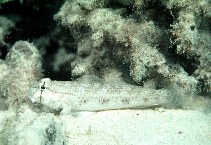| Diagnosis: |
Dorsal spines (total): 6-7; Dorsal soft rays (total): 11-11; Anal spines: 1-1; Anal soft rays: 11-11. Distinguished by the following characteristics: ctenoid scales on head, predorsal midline and pectoral fin base, distinct flap present at end of lower lip; at least three dark spots along first spine of first and second dorsal fins, followed by at least three rows of dark spots or short streaks, pectoral fin with rows of fine dark and white speckles; second dorsal and anal fin rays nearly always I,11; pectoral rays 14-17, modally 16; lateral scales 25-29, modally 27; predorsal scales 7-13, usually 9-10, mostly ctenoid, may be cycloid anteriorly or toward midline; body compressed, width at anus 11.9-28.1% (mean 15.2%) of SL; body stocky in appearance, body depth at anus 19.6-26.6% of SL, body depth at first dorsal fin origin 14.3-27.7% of SL; head compressed, broader ventrally, slightly deeper than wide, HL 26.6-33.3% of SL; head depth at posterior preopercular margin 62.0-83.7% of HL; head width at posterior preopercular margin 53.7-82.2% of HL; head profile bluntly pointed; nape slightly convex behind eyes; mouth subterminal to nearly terminal, slightly oblique; jaws generally reaching to below anterior margin of eye; upper jaw length 32.0-41.5% of HL; upper lip smooth, narrower than lower, lower lip papillose close to teeth, with twist or fold posteriorly, forming triangular flap, lip interrupted at chin; eye moderate to relatively small in large specimens, dorsolateral, 22.7-30.5% of HL; preorbital width 18.2-27.8% of HL; snout bluntly pointed, 22.4-44.4% of HL; posterior naris round to almost triangular, close to anterior margin of eye; anterior naris in short tube, higher on posterior margin of eye, about level with middle of eye or somewhat ventral to it; interorbital narrow, 4.7-11.3% of HL; caudal peduncle compressed, length 12.9-18.6% (mean 16.1%) of SL; caudal peduncle depth 10.7-13.8% of SL (Ref. 92171). |
